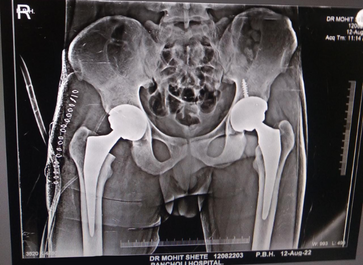- drmrs75@gmail.com
- +91 8080640148 | +91 8692962726

What is Total Hip Replacement?
In total hip replacement (THR), our surgeon removes the damaged sections of the hip joint and replaces them with parts usually constructed of metal, ceramic and very hard plastic. This artificial joint (prosthesis) helps reduce pain, improve function & early mobilization of the patient.
THR might be an option if hip pain interferes with daily activities and nonsurgical treatments haven't helped or are no longer effective. avascular necrosis of femoral head is the most common indication for total hip replacement surgery.
How you prepare
Before the operation
You'll have an examInation with the orthopedic surgeon. The surgeon may:
Ask about your medical history, current / prolonged medications, usage of steroids if any. Later the doctor will Examines your hip, paying attention to the range of motion in your joint and the strength of the surrounding muscles.
Order blood tests and an X-ray. An MRI is usually needed for suspected AVN.
During the procedure
The procedure is usually done under spinal / spinal & epidural anaesthesia.
The surgical procedure can be completed within two hours. To perform a hip replacement, the surgeon:
Makes an incision over the hip, through the layers of tissue
Removes diseased and damaged bone and cartilage, leaving healthy bone intact
Implants the replacement socket into the pelvic bone
Inserts a metal stem into the top of the thighbone, which is then topped with a replacement ball
After the procedure
After surgery, you'll be moved to a recovery area for a few hours while your anesthesia wears off. Medical staff will monitor your blood pressure, pulse, alertness, pain or comfort level, and your need for medications. You'll be asked to breathe deeply, cough or blow into a device to help keep fluid out of your lungs. The length of hospital stay after surgery depends on your individual needs.